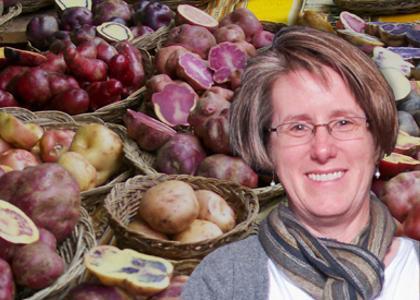Applying Genomic Technology and Bioinformatics to Improve Agriculture

Genomics, since its inception, has been a transformative discipline. With a background in plant biology and plant pathology, Dr. Buell’s research activities center on genomics, bioinformatics and computational biology of plants and their pathogens. Primarily, this has involved the acquisition of large datasets (genome and transcriptome sequence, expression profiles, annotation, etc.) and the use of bioinformatic and computational biology analyses to improve our understanding of plant biology—all dependent on access to high-performance computing capabilities.
A central component of their research program has been collaborations with plant biologists and pathologists to bring together domain knowledge in biology, genomics, and bioinformatics. This has enhanced natural synergies and enabled biology-driven hypotheses to be tested using genomics. Current research projects are focused on high throughput sequencing, functional genomics, comparative genomics, and bioinformatics that are funded by the Department of Agriculture, the National Science Foundation and the Department of Energy. Below are two projects that highlight some of the work this research team has focused on. These projects have enhanced our understanding of crop species, and both have been enabled by access to the computing capabilities of the HPCC.
On a worldwide basis, rice is the second-most important crop, with half of the world’s population dependent on it for a significant portion of their caloric intake. With a relatively small genome size of ~400 million base pairs, the genome sequences of multiple rice cultivars are now available. One intriguing feature of plant genomes is the high density of transposable elements, the so-called “jumping genes” initially discovered by Barbara McClintock in the 1940s. One class of transposable elements, the Pack-MULEs, has the potential to create new genes in a genome. In collaboration with Dr. Ning Jiang, MSU Horticulture Department, the Buell lab is determining the potential for Pack-MULEs to create new genes in the rice genome through their transposition activity. This involves sequencing additional rice cultivars and exploring epigenetic and expression features of Pack-MULEs that indicate they may function as bona fide genes. The lab uses the HPCC to process, analyze and store the terabytes of sequence data generated by this project.
One source of renewable energy is the conversion of plant-based biomass (or feedstocks) into biofuels such as ethanol. A number of biofuel feedstock research programs are focused on improving biomass production in grass species such as maize (corn) and switchgrass. This is due to the potential for energy conversion of plant-derived biomass, established agricultural production methods for maize and switchgrass, and high biomass yields. Dr. Buell developed the Biofuel Feedstock Genomics Resource which provides a web-based portal or “clearing house” for genome sequence and annotation data, germplasm data, and large-scale functional genomic datasets for plant species relevant to biofuel feedstock production. In collaboration with Drs. Shawn Kaeppler, Natalia de Leon, and Mike Casler at the University of Wisconsin, Beull’s lab is identifying natural variants in maize and switchgrass to target for improved biomass production and recalcitrance in these two species. This project is part of the Great Lakes Bioenergy Research Center, a research collaboration between MSU and the University of Wisconsin. Their work to date has included development of a maize gene atlas, characterization of genotypic diversity in maize, analysis of switchgrass transcriptome diversity, and development of an exon capture array for switchgrass. Due to the speed and volume of next-generation sequencing data being generated in this project, they exploit the capabilities of the HPCC with access to hundreds of processors and terabytes of data storage. These collaborative efforts, in which genomics and bioinformatics are coupled with breeding efforts, will enhance the efficiency and success in breeding crop species for biofuel feedstock use and contributing to the increased use of renewable energy sources.
